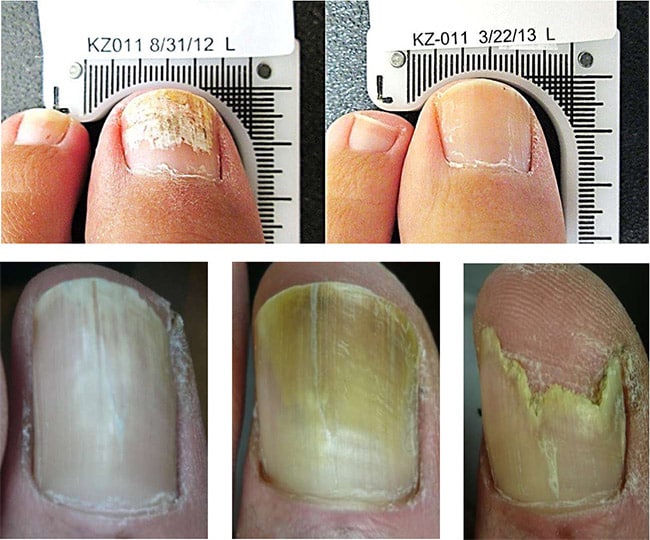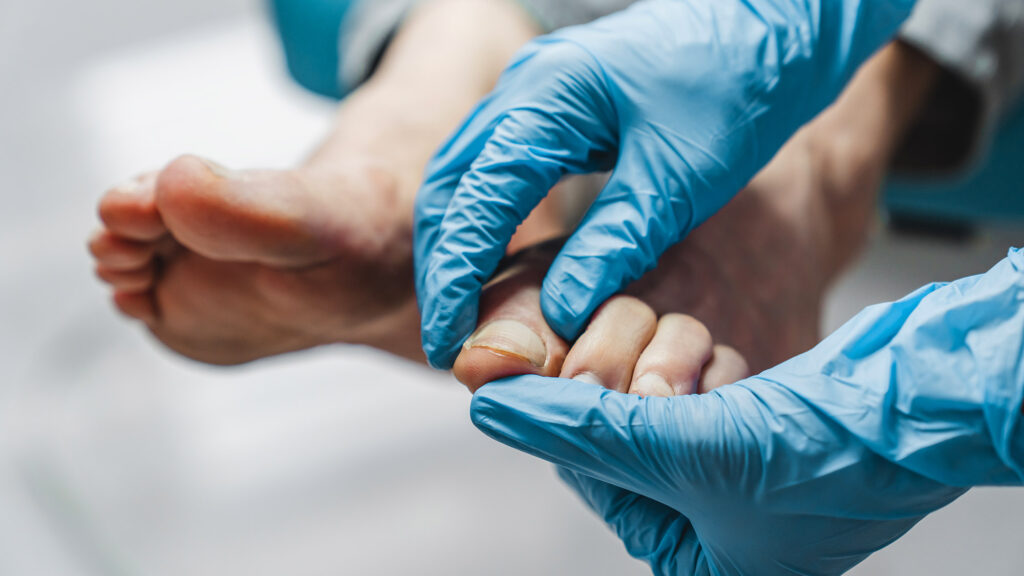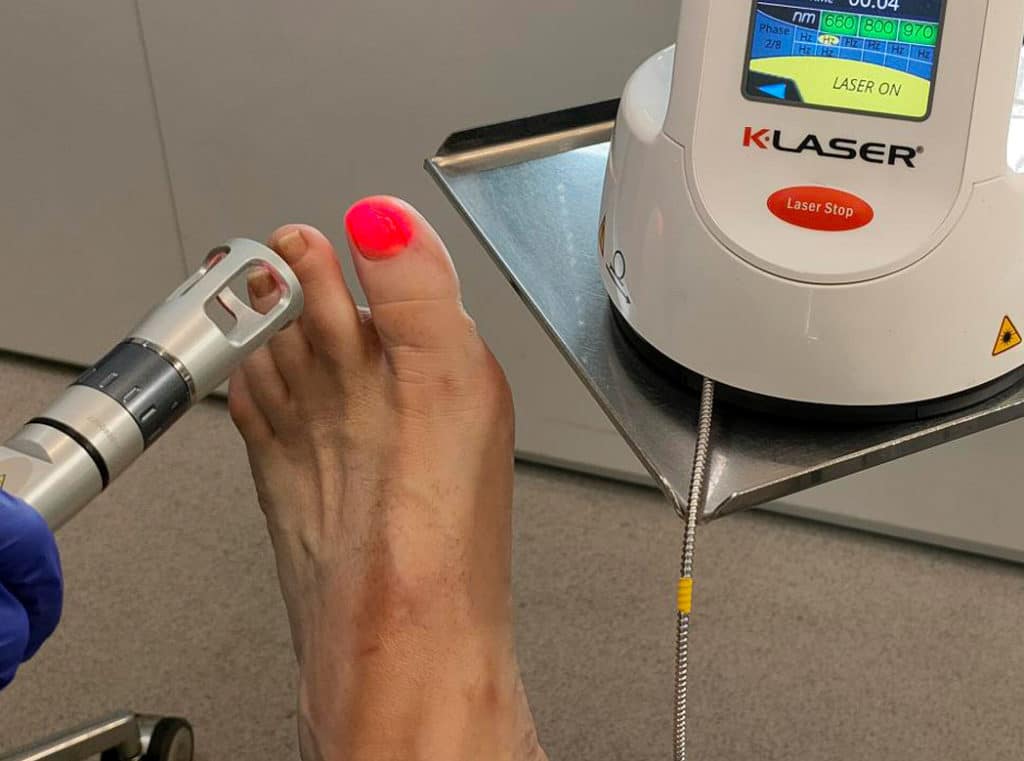Understanding fungal nail infections
The first thing to say is having a fungal infection of the nails or surrounding skin is complex and often very difficult to eradicate
Fungal nail infections occur when a fungal microbe invades the nail structure, causing thickening, discolouration, and splitting or crumbly nails. From white ‘flecks’ on the nail surface of an early fungal infection to very thick brown nails covering active brown fungal ‘paste’ with an unpleasant smell. Fungus within nails can equally affect toe and fingernails – but is much more common within toenails, which will be explained next.
Fungal nail infections can be caused by various factors, including warm, moist environments, poor hygiene, and weakened immune systems. Identifying symptoms such as thickening, discolouration, and brittleness is crucial, and discussing treatment options, including laser therapies, can help manage fungal nails effectively. All these factors can play their part, but when it comes to toenail fungus, I feel the number one factor is the environment in which we keep our feet.
Think about it…
We live in the UK, which is mainly a cold, damp place, leading us to constantly wear closed-in shoes, wellington boots, trainers, slippers, nail varnish, etc. The feet and nails are kept continuously warm and dark with perspiration, creating a moist environment (very similar to a mushroom farm environment).
Therefore, once a very small fungal infection takes hold, we provide the perfect environment for the fungus to grow and spread, leading to additional problems:-
- If left untreated, fungal nail infections can lead to pain, irritation, and pressure on the surrounding skin.
- Common symptoms of fungal nail infections include thickening, discolouration, brittleness and very unpleasant odour of the nail.
- Fungal nail infections can cause the nail to become distorted, separated from the nail bed (lysis), or even fall off, leaving the toe open to further trauma and injury.
- Fungal nail infections can also cause pain, irritation, and pressure on the surrounding skin or develop as an ingrowing nail.
This brings us back to fingernails. They are as susceptible to fungal infection as are toenails except for one factor. Yes, the environment.
At Waverley Clinic, we see and treat fingernail fungal infections and usually find an environmental factor. For example, bikers who use thick insulated gloves, ladies who do housework in Marigold gloves, constant nail varnish use, and gardening gloves. Again, a warm, dark, moist environment provides the fungus and ideal living environment.
NOTE: Important Fact
Remember that fungal nail infections do not ‘self-resolve’ and will continue to develop and spread without some form of treatment. Advice can be provided by your GP, Podiatrist or Pharmacist.
Symptoms of toenail fungus
Recognising the symptoms of toenail fungus is essential for early treatment and effective management. One of the most common signs is the thickening of the nail, which can become brittle and difficult to trim. The discolouration is another telltale symptom, with the nail turning yellow, green, black, or white due to the presence of fungi.
In more severe cases, the nail may lift from the nail bed, causing pain and discomfort. This separation can make everyday activities, such as walking or wearing shoes, quite painful. Additionally, fungal infections can cause a foul odour to emanate from the affected nail, which can be both unpleasant and embarrassing.

Suggestions on how to treat nail fungal infections
Prescription medications: your doctor may prescribe oral antifungal medication or topical creams to treat your infection. Oral medication treatment is potentially very toxic and is prescribed for three months. Liver and kidney damage risks require pre and post-liver function blood tests.
Over-the-counter treatments: OTC treatments for fungal nail infections are widely available with pharmacies’ advice. These treatments typically include antifungal creams, ointments, and nail varnishes that can be applied directly to the affected area.
Home remedies:
Some people prefer to use natural remedies such as tea tree oil or apple cider vinegar to treat their fungal nail infections.
- Tea tree oil: known for its antifungal properties, tea tree oil can be applied directly to the affected nail and surrounding skin.
- Apple cider vinegar: soaking the feet in a solution of apple cider vinegar and water may help reduce the growth of fungi.
- Garlic: crushed garlic cloves can be mixed with olive oil and applied to the affected area as a natural antifungal treatment.
While these remedies may provide some relief, there is limited scientific evidence to support their effectiveness.
‘Cold’ Laser treatment: cold laser therapy is a relatively new treatment option for fungal nail infections. This involves using a laser to target and kill the fungi causing the infection. While this can be an effective option, it is often more successful but expensive than other treatments.
Treating fungal nail infections effectively can significantly improve a patient’s confidence and lifestyle.
Types of fungal nail infections
Fungal nail infections come in various forms, each caused by different types of fungi. Dermatophyte infections are the most common, caused by fungi such as Trichophyton, Microsporum, and Epidermophyton. These infections typically affect the nail plate and can be quite persistent.
Non-dermatophyte infections, on the other hand, are caused by fungi like Candida, Aspergillus, and Fusarium. These infections can be more challenging to treat and may require a different approach. Yeast infections caused by Candida can affect both the nail plate and the surrounding skin, leading to a range of symptoms.
Waverley Clinic experience and difference
Here at Waverley Clinic, we have specialised in fungal nail treatment for almost ten years, utilising advanced methods such as laser therapy. Through experience and successful clinical results, we have developed a high level of expertise and success. Waverley Clinic offers the two most advanced ‘cold’ laser technologies designed for targeted eradication of fungal infections.
Choose between our Lunala Laser and K-Laser fungal nail therapy options.
Waverley Clinic’s technologies are 80% successful in clearing the infection and promoting the growth of a healthy nail.
Our podiatrists and physiotherapists are all qualified to Degree BSc level, registered with the HCPC, and fully insured.
However: NOT ALL CLINICS OFFER THE SAME LASER TECHNOLOGY, EXPERIENCE OR SUCCESS!! –
Always ask the clinic a few questions:-
- What is their experience in treating nail fungus?
- What laser therapy device do they use?
- How does the laser device work?
- What are the published clinical results?
- How many patients have they treated successfully?
Laser therapy: What should you expect during the treatment?
During the treatment, the laser will be applied to the affected nail for a few minutes.
Two different laser therapy heads are used with each treatment, providing changes in wavelength needed to kill the fungal organism and stimulate the immune system and nail growth.
The treatment is pain-free, but some patients may feel a mild warming sensation.
The treatment is typically performed in four appointment sessions, spaced about seven days apart.
Occasionally, very advanced fungal infections may require additional treatment sessions. This can be discussed and planned during the first ‘Fungal Infection Assessment’ appointment. Early treatment of toenail fungus infection is crucial to prevent complications and ensure effective results.

Preparation and aftercare instructions
- Before the treatment, the patient should remove any nail polish.
- Bring a clean pair of socks to use following the treatment
- After the treatment, the patient should avoid using nail polish
- The patient should also keep the treated nail area clean and dry to promote healthy nail growth.
- The patient may be advised to use topical creams or other treatments to prevent new infection and to help promote healthy nail growth. Following these instructions is crucial to effectively treat fungal nail infections and prevent further spread.
How many sessions do I need for fungal nail laser treatment?
The number of sessions needed for fungal nail laser treatment can vary depending on the severity of the infection and the individual’s response to treatment. On average, four sessions are required for successful eradication of the fungal infection. In some cases, additional sessions may be necessary if the infection is more advanced. It is important to follow up with your podiatrist or physician to ensure proper healing and prevention of future infections.
Overall, it is important to have patience and continue treatment until the affected nail has grown out completely. With proper care and adherence to aftercare instructions, patients can expect significant improvement in their fungal nail infection and overall foot health.
Advice for good foot hygiene and prevention of new fungal infections
The first thing to say is fungal infections are like every infection and may return!!! A few good ‘daily routine’ actions can reduce the risks:
- Keep your feet clean and dry, especially in between the toes.
- Keep the feet out of shoes and socks as much as possible
- Even in the winter, when at home, use open-toed slippers
- Sheepskin slippers or boots – I’m afraid to say, but it’s the bin!
- Use antifungal foot powder or spray in shoes to help prevent fungal growth.
- Wear protective footwear in public areas such as pools, gyms, and locker rooms.
- Avoid sharing nail clippers, towels, and other personal items with others.
- Choose breathable socks made of natural materials like cotton or bamboo.
- Try open-toe slippers or ‘Yoga Socks’ available from Amazon.
This may seem drastic, but by practising good foot hygiene and taking preventative measures, you can reduce your risk of developing a fungal nail infection.
Treatment plan and schedule
At Waverley Clinic, our treatment plan for fungal nail infections is tailored to each individual’s needs. Typically, the plan involves a series of laser therapy sessions, spaced 2-6 weeks apart. The exact number of sessions required will depend on the severity of the infection and how well the individual responds to treatment.
Our experienced practitioners will assess your condition and develop a personalised treatment plan aimed at achieving healthy nail growth and eliminating the fungal infection. This approach ensures that each patient receives the most effective care possible.
Factors affecting number of sessions
Several factors can influence the number of laser therapy sessions required to treat a fungal nail infection. The severity of the infection is a primary consideration; more severe infections may necessitate additional sessions to fully eradicate the fungus.
The size of the affected area also plays a role, as larger areas may require more sessions to ensure complete coverage. Individual response to treatment can vary, with some people responding more quickly than others, potentially reducing the number of sessions needed.
Underlying medical conditions, such as diabetes, can affect the body’s ability to fight off fungal infections, possibly requiring more sessions. It’s essential to note that laser therapy is a safe and effective treatment option with minimal downtime and few side effects. Our experienced Podiatrists will work with you to develop a personalised treatment plan to help you achieve healthy nail growth and eliminate fungal infections.

Key takeaway nail fungus treatment points
High success rate and long-term results
- Laser treatment for nail fungus has a high success rate, with some studies showing over 80% effectiveness.
- The patient should choose a qualified practitioner (Podiatrist) with experience in laser treatment for nail fungus.
- Ask the clinic about their Laser Therapy experience and success
- The results of laser treatment for nail fungus can be long-lasting, with some patients experiencing complete clearance of the infection within months.
- Laser treatment for nail fungus can promote healthy nail growth and prevent the spread of the infection.
Both fungal infection treatment and immune response stimulation
- Laser treatment for nail fungus is suitable for all ages and nail types (over 16 years old)
- The treatment is non-invasive and pain-free.
- The treatment can be used to treat both toenail and fingernail fungal infections.
- The cost of ‘cold’ laser therapy is based upon treating a course of four initial treatments.
Clinical review/checkup with laser treatment five weeks after the course is included (total of five laser treatments):
Laser Therapy to treat up to five nails – £510.00
Laser Therapy to treat up to 10 nails – £660.00
The cost of treatment may seem high, but it is a valuable investment in your health and well-being. - Excellent clinical results and published over 80% success rates
You should consider the cost of treatment in relation to the benefits of the treatment, including the high success rate and long-term new infection prevention
Schedule your fungal nail laser treatment at Waverley Clinic in Farnham, Surrey, today.
Don’t let a fungal nail infection affect your daily life and confidence any longer. With our safe and effective laser treatment, you can expect significant improvement in the appearance of your nails and overall foot health.
To schedule a Nail Fungus assessment appointment, please call our 7-day reception booking service at 01252 716611. Feel free to call if you have any questions or need further discussion.

